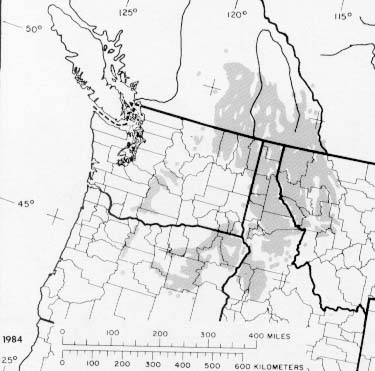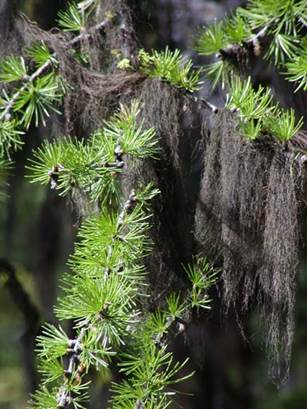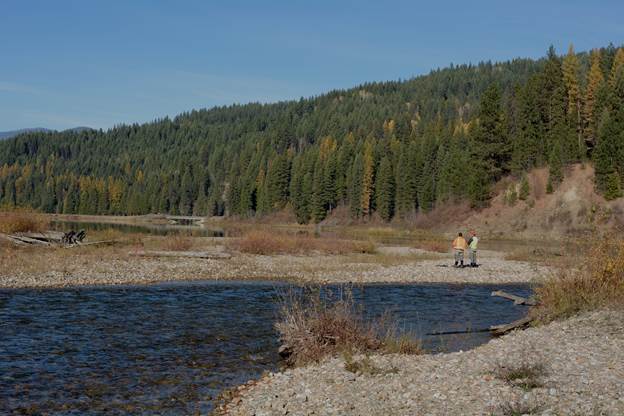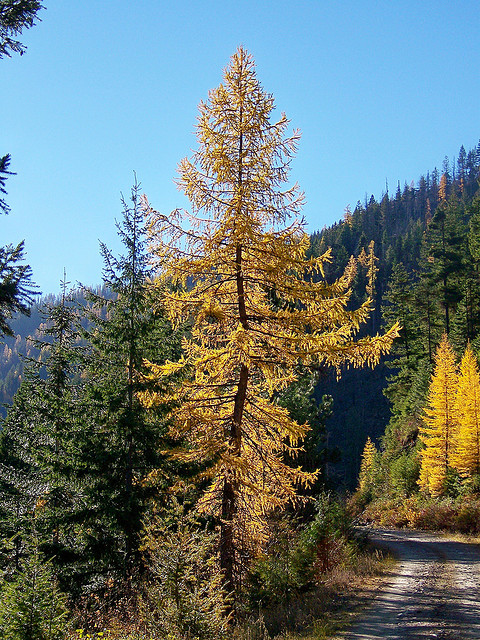Lewis’s river appeas to pass through these mots. near their N. Eastern extremity. these hills terminate in a high level plain between the Kooskooske and Lewis’s river. These plains are in many places well covered with the Longleafed pine, with some Larch and balsom fir. The soil is extreemly fertile no dose it appear so thisty as that of the same apparent texture of the open plains. It produces great quantities of the quawmash a root of which the natives are extreemly fond. A great portion of the Chopunnish we are informed are now distributed in small vilages through this plain collecting the quawmash and cows; the salmon not yet having arrived to call them to the river. Merriweather Lewis, May 4th, 1806.
Western larch is a member of the pine family (Pinacae) and is a deciduous conifer – thus it has needles but these are shed each autumn and the tree is bare of leaves over the winter, growing a new set in the spring. Western larch is often confused with alpine larch (L. lyallii), its cousin that lives at the higher altitudes in the Cascades and Rockies. Western larch has a range that includes the upper Columbia River Basin of northwestern Montana, north and west central Idaho, northeast Washington, southeast British Columbia, along the east slopes of the Cascade Mountains in Washington and north-central Oregon, and the Blue and Wallowa Mountains of southeast Washington and northeast Oregon.

This larch has an interesting affiliation with temperature and moisture regime and grows in a moist-cool climate zone with low temperature limiting its upper elevational range and low moisture limiting its low elevation range. Compiled data for OR, WA, ID, and MT indicate that larches habitat includes annual maximum temperature of 84 F, minimum of 15 F, and total snowfall of 103 inches. It can tolerate a range of soil types but deep and well drained soils are most suitable.
Larch’s typically are found along valley bottoms, benches, and east and north-facing slopes. South and west exposures are often too warm for seedling to establish.
Larix from the Celtic lar, or fat – referring to the abundant resin; and occidentalis – referring to its distribution in portions of the western U.S.
The tree was first described by Thomas Nuttal in 1849 noting – We met with this apparently distinct species of Larch in the coves of the Rocky Mountains on the western slopes towards Oregon.
It was encounter by Lewis and Clark in the upper Clearwater Basin and by David Douglas in 1827 outside of Fort Colville, though he believed it to be the same as the European larch. Nuttal set the record straight. Western larch are monoecious (Latin for “one house”) where the tree contains both male and female flowers. Pollination occurs in late May through June and cones complete their development in one season, maturing by mid- to late August. Cones generally fall from the tree during the winter but some may remain attached into the following summer. Seed production tends to reach a climax in five year intervals. About 80 seeds per cone are produced and with the attached wing can disperse in the wind up to 780 feet, though the average is around 120 feet or so.
Seedlings can be affected by fungi when they grow on duff and appear to prefer partially shaded mineral soil. Larches can grow quite large and are long-lived. Specimens have exceeded 90 inches in dbh (diameter at breast height), 200 ft tall, and have been recorded to reach 900 years old. While it is somewhat tolerant of shade as a seedling, as it grows it becomes less tolerant and tends to grow in even-aged stands. Adjacent species may appear to be younger because larch grows faster.
Because of its thick bark older larch are quite fire-resistant. Dwarf-mistletoe is the most damaging, disease-causing parasite affecting larch. Other disease vectors include quine fungus, western spruce budworm, larch casebearer, and larch sawfly. Larch is an aggressive pioneer species and quickly inhabits areas with natural or man-made openings in the forest. The wood is used for lumber, fine veneer, straight utility poles, railroad ties, mine timbers, and pulpwood. It also is a source for arabinogalactan, a water soluble gum used in offset lithography, food, pharmaceutical, paint, ink, and other industries. Who knew? Supposedly it was used by some Plateau Indian Tribes to treat various maladies including tuberculosis and laryngitis. The leaves grow of clusters and in the autumn turn yellow and then are shed.

I’ve been doing some work on a couple projects up in the far northeast corner of WA near Canada and Idaho on the Colville National Forest where this tree is abundant. As the autumn progressed they were easy to pick out as they turned yellow, which contrasted sharply with the green of the Douglas fir, grand fir, western red cedar, western hemlock, and occasional western white pine. Tom, one of our archaeologists was working in the forest up there at the height of larch color and let me know that it was a windy day and it was “raining” larch needles all day. Quite the image.

